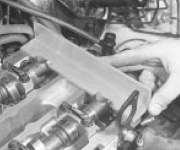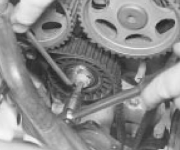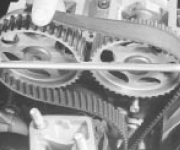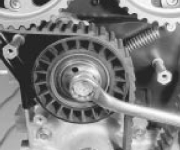Ford Mondeo timing belt removal, refitting and adjustment - is a part of Ford Mondeo repair manuals: Engines. This part contains the detailed description of engine repair procedures and engine diagrams for Ford Mondeo with four-cylinder petrol engines, including special/limited editions (1597cc, 1796cc, 1988cc), Diesel and V6 engines.
With the vehicle parked on firm level ground, open the bonnet and disconnect the battery negative (earth) lead. Unbolt the power steering high-pressure pipe from the cylinder head rear support plate/engine lifting eye, and from the front support plate/pump bracket. Unscrew the six nuts securing the engine/transmission right-hand mounting bracket, then withdraw the bracket. Slacken the water pump pulley bolts. Remove the cylinder head cover. Ford Mondeo timing belt and cover details:
Ford Mondeo timing belt and cover details:1 - timing belt upper cover;
2 - inlet camshaft toothed pulley;
3 - exhaust camshaft toothed pulley;
4 - timing belt;
5 - timing belt tensioner;
6 - crankshaft toothed pulley;
7 - timing belt middle cover;
8 - timing belt lower cover;
9 - crankshaft pulley;
10 - water pump pulley.
Remove the spark plugs, covering their holes with clean rag, to prevent dirt or other foreign bodies from dropping in. Remove the auxiliary drivebelt. Rotate the crankshaft clockwise until the second pair of notches in the pulley rim align with the edge of the sump mark, so that Nos 1 and 4 cylinders are at TDC. Unbolt and remove the water pump pulley and the auxiliary drivebelt idler pulley. Obtain Ford service tool 21-162, or fabricate a substitute from a strip of metal 5 mm thick (while the strip's thickness is critical, its length and width are not, but should be approximately 180 to 230 mm by 20 to 30 mm). Check that Nos 1 and 4 cylinders are at Top Dead Centre (TDC) - No 1 on the compression stroke - by resting this tool on the cylinder head mating surface, and sliding it into the slot in the left-hand end of both camshafts. The tool should slip snugly into both slots while resting on the cylinder head mating surface; if one camshaft is only slightly out of alignment, it is permissible to use an open-ended spanner to rotate the camshaft gently and carefully until the tool will fit. If both camshaft slots (they are machined significantly off-centre) are below the level of the cylinder head mating surface, rotate the crankshaft through one full turn clockwise and fit the tool again; it should now fit as described in the previous paragraph. With the camshaft aligning tool remaining in place, remove the crankshaft pulley. Do not use the locked camshafts to prevent the crankshaft from rotating. Remove the timing belt lower and middle covers. With the camshaft aligning tool still in place, slacken the tensioner bolt, and use an Allen key inserted into its centre to rotate the tensioner clockwise as far as possible away from the belt; retighten the bolt to secure the tensioner clear of the timing belt. If the timing belt is to be re-used, use white paint or similar to mark its direction of rotation, and note from the manufacturer's markings which way round it is fitted. Withdraw the belt. Do not rotate the crankshaft until the timing belt is refitted. If the belt is being removed for reasons other than routine renewal, check it carefully for any signs of uneven wear, splitting, cracks (especially at the roots of the belt teeth) or contamination with oil or coolant. Renew the belt if there is the slightest doubt about its condition.
 |
 |  |  |
As a safety measure, the belt must be renewed; if its history is unknown, the belt should be renewed irrespective of its apparent condition whenever the engine is overhauled. Similarly, check the tensioner spring (where fitted), renewing it if there is any doubt about its condition. Check also the toothed pulleys for signs of wear or damage, and ensure that the tensioner and guide pulleys rotate smoothly on their bearings; renew any worn or damaged components. If signs of oil or coolant contamination are found, trace the source of the leak and rectify it, then wash down the engine timing belt area and related components, to remove all traces of oil or coolant. On reassembly, temporarily refit the crankshaft pulley, to check that the pulley notches and sump rib are aligned, then ensure that both camshafts are aligned at TDC by the special tool. If the engine is being reassembled after major dismantling, both camshaft toothed pulleys should be free to rotate on their respective camshafts; if the timing belt alone is being renewed, both pulleys should still be securely fastened. A holding tool will be required to prevent the camshaft toothed pulleys from rotating while their bolts are slackened and retightened; either obtain Ford service tool 15-030A, or fabricate a substitute as follows. Find two lengths of steel strip, one approximately 600 mm long and the other about 200 mm, and three bolts with nuts and washers; one nut and bolt forming the pivot of a forked tool, with the remaining nuts and bolts at the tips of the "forks", to engage with the pulley spokes as shown in the accompanying illustrations. Note: Do not use the camshaft aligning tool (whether genuine Ford or not) to prevent rotation while the camshaft toothed pulley bolts are slackened or tightened; the risk of damage to the camshaft concerned and to the cylinder head is far too great. Use only a forked holding tool applied directly to the pulleys, as described. If it is being fitted for the first time, screw the timing belt tensioner spring retaining pin into the cylinder head, tightening it to the specified torque wrench setting. Unbolt the tensioner, hook the spring on to the pin and the tensioner backplate, then refit the tensioner, engaging its backplate on the locating peg. In all cases, slacken the tensioner bolt (if necessary), and use an Allen key inserted into its centre to rotate the tensioner clockwise as far as possible against spring tension, then retighten the bolt to secure the tensioner. Fit the timing belt; if the original is being refitted, ensure that the marks and notes made on removal are followed, so that the belt is refitted the same way round, and to run in the same direction. Starting at the crankshaft toothed pulley, work anti-clockwise around the camshaft toothed pulleys and tensioner, finishing off at the rear guide pulley. The front run, between the crankshaft and the exhaust camshaft toothed pulleys, must be kept taut, without altering the position either of the crankshaft or of the camshaft(s) - if necessary, the position of the camshaft toothed pulleys can be altered by rotating each on its camshaft (which remains fixed by the aligning tool). Where the pulley is still fastened, use the holding tool described in paragraph 18 above to prevent the pulley from rotating while its retaining bolt is slackened - the pulley can then be rotated on the camshaft until the belt will slip into place; retighten the pulley bolt.
 |
 |  |  |
When the belt is in place, slacken the tensioner bolt gently until the spring pulls the tensioner against the belt; the tensioner should be retained correctly against the timing belt inner shield and cylinder head, but must be just free to respond to changes in belt tension. Tighten both camshaft toothed pulley bolts (or check that they are tight, as applicable) and remove the camshaft aligning tool. Temporarily refit the crankshaft pulley, and rotate the crankshaft through two full turns clockwise to settle and tension the timing belt, returning the crankshaft (pulley notches) to the position described in paragraph 8 above. Refit the camshaft aligning tool; it should slip into place as described in paragraph 10. If all is well, proceed to paragraph 26 below. If one camshaft is only just out of line, fit the forked holding tool to its toothed pulley, adjust its position as required, and check that any slack created has been taken up by the tensioner; rotate the crankshaft through two further turns clockwise, and refit the camshaft aligning tool to check that it now fits as it should. If all is well, proceed to paragraph 26 below. If either camshaft is significantly out of line, use the holding tool described in paragraph 18 above to prevent its pulley from rotating while its retaining bolt is slackened -the camshaft can then be rotated (gently and carefully, using an open-ended spanner) until the camshaft aligning tool will slip into place; take care not to disturb the relationship of the pulley to the timing belt. Without disturbing the pulley's new position on the camshaft, tighten the pulley bolt to its specified torque wrench setting (see illustration). Remove the camshaft aligning tool, rotate the crankshaft through two further turns clockwise and refit the tool to check that it now fits as it should. When the timing belt has been settled at its correct tension, and the camshaft aligning tool fits correctly when the crankshaft pulley notches are exactly aligned, tighten the tensioner bolt to its specified torque wrench setting (see illustration). Fitting the forked holding tool to the spokes of each pulley in turn, check that the pulley bolts are tightened to their specified torque wrench setting. Remove the camshaft aligning tool, rotate the crankshaft through two further turns clockwise, and refit the tool to make a final check that it fits as it should. The remainder of the reassembly procedure is the reverse of removal, noting the following points: tighten all fasteners to the torque wrench settings specified; when reassembling the engine / transmission right-hand mounting, renew the self-locking nuts, and do not allow the mounting to twist as the middle two of the bracket's six nuts are tightened.
from Ford Mondeo repair manuals
